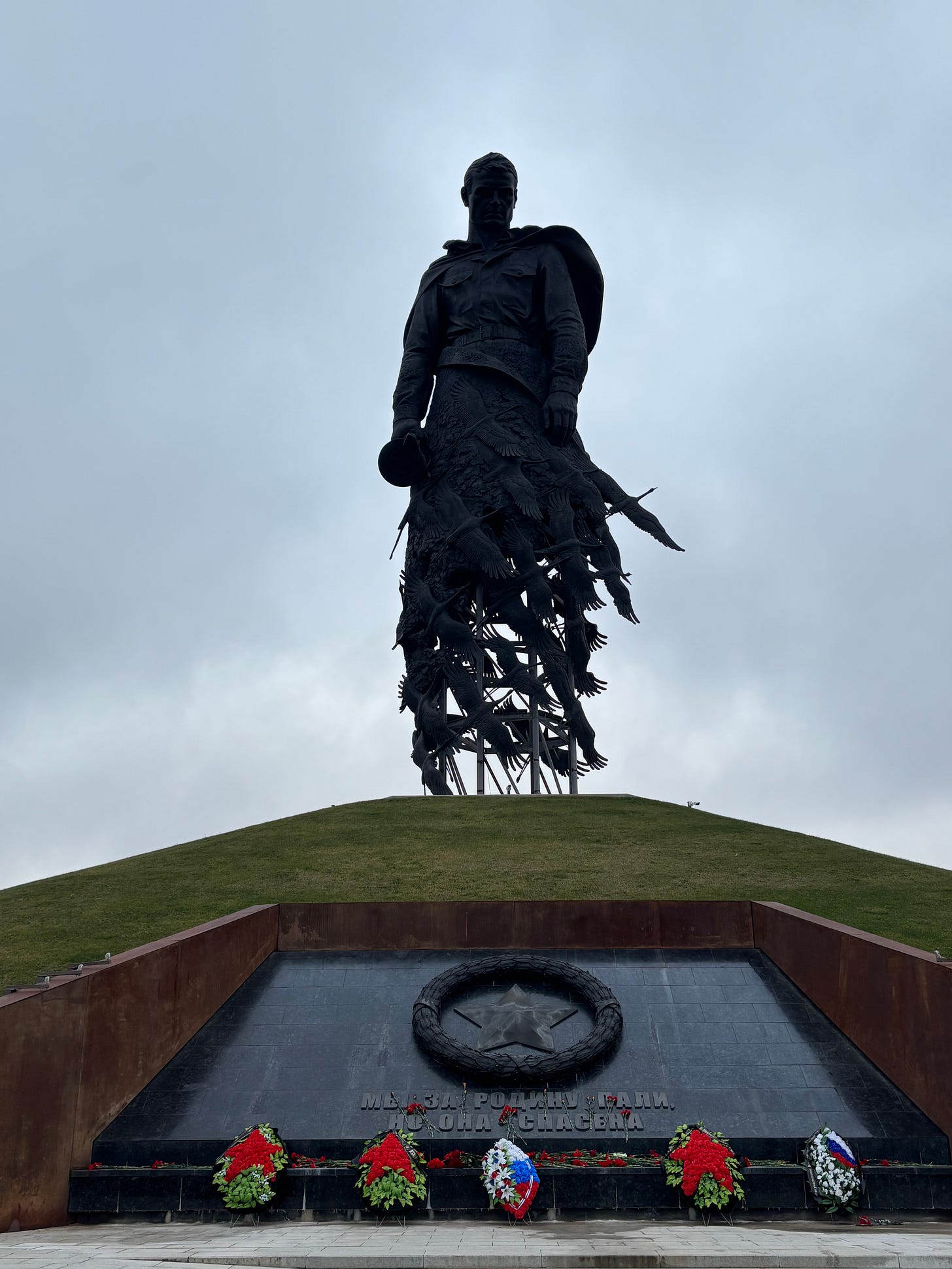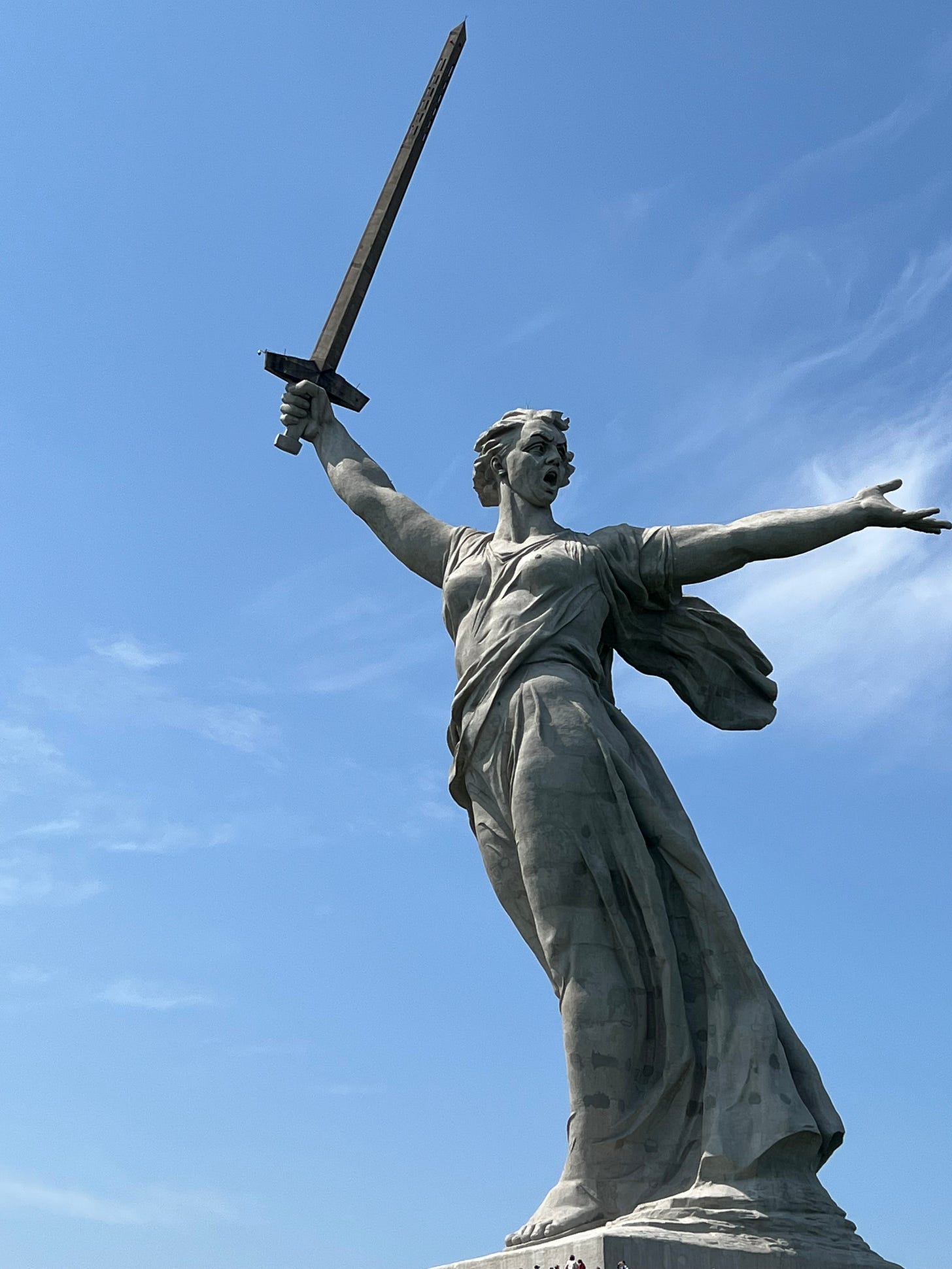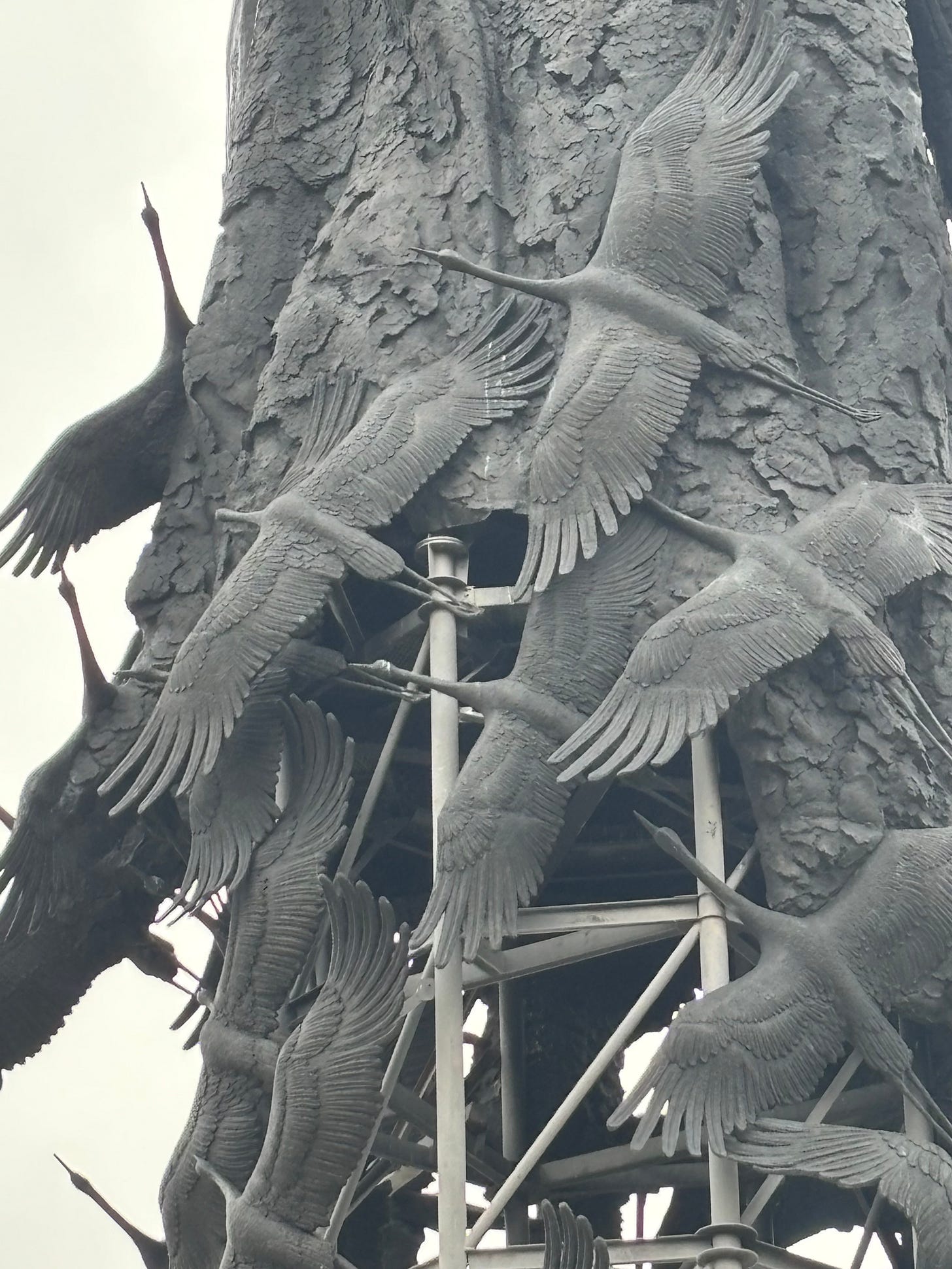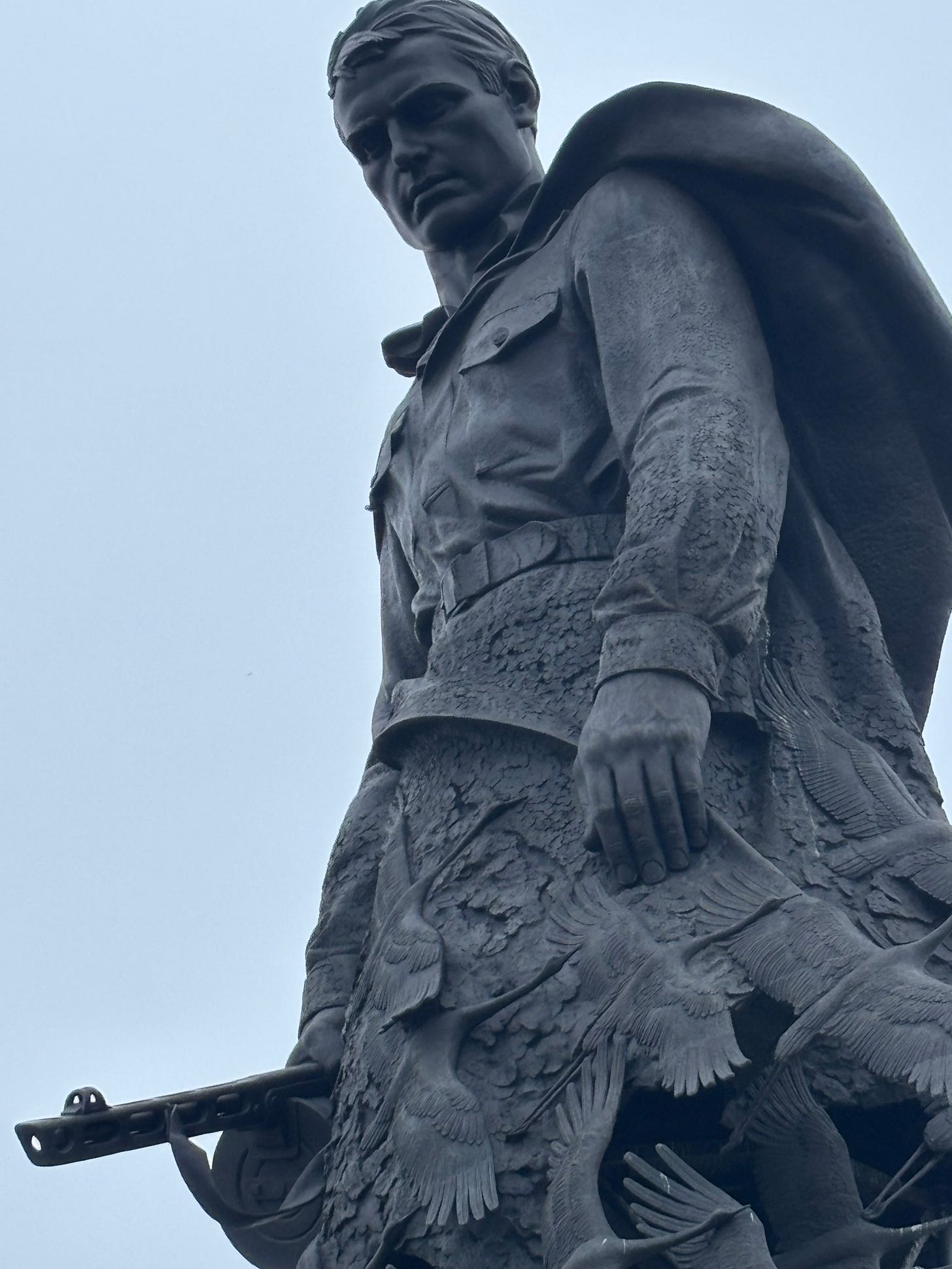Sometimes it seems to me that the soldiers,
Which haven’t returned from blood’s fields,
Haven’t layed in our land,
But have turned into white cranes.
War is the ultimate form of human tragedy, the organized act of humans slaughtering humans. While war is logically to be avoided, often the conflict between humankind manifests itself violently. Rarely, however, do such conflicts allow for a clear delineation between right versus wrong, good versus evil.
The Soviet fight against Nazi Germany during the Second World War is one of these historical rarities. It should come as no surprise that the people who suffered so greatly in such a horrible yet just cause would seek to memorialize this suffering, and the victory born of it, with monuments that enable future generations to never forget the sacrifices made so that future generations might live free of the same tyranny which once stalked the soil of Mother Russia.
The battle for Stalingrad has been carved into the Pantheon of history’s most epic battles. This titanic struggle on the shores of the Volga River caused some 1.37 million Red Army casualties and claimed the lives of another 235,000 civilians. It has been called ‘the most brutal clash of arms in the most terrible of twentieth-century wars”, and the “the most important military-political event of World War II”. Germany would never recover from this defeat, and for this reason the battle for Stalingrad has been described by many as the turning point in the war against fascist Germany.
From those distant times
They fly and we hear their voices.
Is it because so often and so sadly
We are falling silent and looking into heaven?
Conceived and designed in the 1950’s, built in the 1960’s, and unveiled in 1967, the giant state mounted atop the Mamayev Kurgan hill in the city of Volgograd stands 285 feet tall. “The Motherland Calls” is but one of scores of statues that, together, make up the memorial to the Battle of Stalingrad. But this one dominates all others, a soaring tribute to a nation and the spirit of its people. Standing on a hill which—literally—serves as the final resting place of tens of thousands of Red Army soldiers and Soviet civilians alike, “The Motherland Calls” is a powerful manifestation of a nation willing and able to sacrifice its individual citizens by the millions in defense of the greater good.
“The Motherland Calls” confronts Europe and the lands that gave birth to the fascist enemy that met its fate in and around the city that bore Stalin’s name (in addition to the German soldiers who fell or were captured, hundreds of thousands of Italian, Hungarian, and Romanian troops perished at the hands of the Red Army.) But she beckons the strength of Russia that stretches back through Siberia and the shores of the Pacific Ocean. The strength and determination of a nation and its people is manifest in this glorious monument, evoking powerful emotions to those who have looked upon it.
The symbolism of a mother beckoning to her sons to go forth to defend the motherland is juxtaposed by another monument, “Mother’s Sorrow”, which depicts a Soviet mother cradling the slain body of her son, surrounded by a lake of tears. Here the harsh truth or war is laid bare for all to see, the reality of the consequences of conflict and the horrible cost paid by those who are called upon to participate.
The tired crane flock flies, flies through the sky,
Flies in the mist at the end of the day.
And it is a small gap in this order -
Perhaps this place is for me.
The Mamayev Kurgan Memorial was built to honor the Soviet dead of Stalingrad, to ensure that their sacrifice would never be forgotten, and their deeds forever remembered.
It is a memorial to victory.
Outside the City of Rzhev, located in the Rzhevsky District of the Tver Oblast, about two hours travel by car west of Moscow, is another memorial to the fallen of the Great Patriotic War. “The Memorial to the Soviet Soldier” commemorates sacrifices made by the Red Army at the same time the Battle of Stalingrad raged. From January 1942 to March 1943 a series of battles were fought in and around Rzhev which, according to official Soviet sources, killed 392,554 Red Army soldiers and wounded another 768,233. Yet in 2007, Russian historians began publishing a different account, which listed the total killed as being in excess of 2 million. It is not without justification that these battles have collectively become known as the “Rzhev meatgrinder”, and the leadership behind the decisions that led so many men to their deaths being openly criticized. Moreover, the Rzhev battles were, at best, a stalemate, and at worst a Soviet defeat.
Soviet authorities, for cause, did not wish to shine a light on such battles. For them, the Great Patriotic War should be celebrated as a decisive victory over fascism.
There would be no memorial to the fallen at Rzhev.
That is, until a revitalized Russia decided that the sacrifice of all who fell in battle should be recognized.
The Memorial to the Soviet Soldier was opened in 2020. Its design is brutally effective, drawing from the old Russian belief that when a soul dies it is taken to the heavens by a white crane.
The base of the monument consists of a swirl of bronze cranes, emerging from the soul, representing the souls of soldiers long forgotten, and only now remembered
The day will come, and in such crane flock
I’ll swim in the same blue-gray haze.
Calling out like a bird from the heavens
All of you who are left on earth.
It is difficult to understand the strength of the symbolism in this statue, knowing that one is standing on the ground which covered the bodies of so many Soviet fallen that had, for decades, been forgotten and forsaken by a nation which is grounded in preserving the memory of those who fell defeating Nazi Germany.
The cranes swirl, coming together to form the body of a single Soviet Soldier, weapon in hand, looking back down on the ground from which he came. No mother beckons for her sone to come to his defense, and no mother cradles his dead body in her arms. Instead, this soldier stands, strong but forlorn, a symbol of abject sorrow and unspeakable pain.
The Soviet soldiers who died in and around Rzhev helped shape the events that governed the Soviet victory at Stalingrad. The meatgrinder attacks against dug-in German defenders served two primary purposes—to convince the Germans that the main Russia offensive in the winter of 1942-43 would be at Rzhev, and to pin down German divisions that would have otherwise been released to relieve the surrounded German soldiers in Stalingrad.
If it weren’t for the Soviet soldiers who gave their lives in Rzhev, there would have been no victory at Stalingrad, and as such no “The Motherland Calls” statue.
Standing in the shadow of the statue of the Soviet Soldier, one can’t help but feel the ground move as these long-forgotten souls surge forth, freed by the refreshed memory of a nation. The souls move through your body, their energy moving to the statue. Your eyes cannot help but meet the gaze of the soldier staring down at you in a strong yet pained expression, silently asking the question, “Why have you forsaken me for so long?”
It is a question nobody can adequately answer, a reflection of the reality that a nation that forsakes its fallen will never truly learn the costs and consequences of war.
Today Russia remembers.
Sometimes it seems to me that the soldiers,
Which haven’t returned from blood’s fields,
Haven’t layed in our land,
But have turned into white cranes.
“Zhuravili (Cranes)”, Rasul Gamzatov
I am currently travelling in Russia, conducting interviews of prominent Russians in order to help capture the Russian reality and bring it to an American audience. This article was motivated by a visit to the Memorial to the Soviet Solder on November 8, 2025. If you want to see more articles like this, please subscribe. And if you want to help make possible more trips such as this, please donate.







My USA has NEVER faced such a physical, human crisis as a land war on an equal scale, as the Soviets have. Despite how obvious that is, we are cursed with a hubris almost completely unearned. Yes, we have sacrificed in war, but never in percentage, much less the scale that Russians faced, endured and succeeded in thwarting. If we learned to appreciate that fact we might be a better nation.
Very moving, Scott, and so true. I remember the monuments from my two trips to the former USSR.
Interestingly - perhaps not - my first trip, in college (a one-month course through the college), included Babi Yar outside Kiev, but our time in Leningrad (now St. Petersburg) did not include Piskaryovskoye. We had free time, so I told our Intourist guide (she spoke English and I spoke some Russian then) that I was going. She was quietly pleased. Separate from statuary, that cemetery itself, with its rows upon rows of mass graves, is a monument, to the devastation inflicted upon them. Not enough Americans, definitely not enough American politicians, understand that.
I tried to fact-check this, but am certain that, years ago, I read of a survey where 44% of Americans surveyed thought that the USSR was an Axis power. (After all, they're Bad Guys, aren't they?)
Semper fi on this Veterans Day.